Library of Congress's Blog, page 177
March 3, 2013
I Love a Parade

“Official Program of the Woman Suffrage Procession”, Washington, D.C. March 3, 1913
A century ago today, more than 5,000 women—and some intrepid men—marched down Pennsylvania Avenue in the nation’s capital in what was billed as the Woman Suffrage Procession. The following is a guest post by Audrey Fischer, editor of the Library of Congress Magazine.
It had been 65 years since the first women’s rights convention, in Seneca Falls, N.Y., and it would be another seven years until the 19th amendment was ratified, giving women the right to cast their ballots. Every year since 1869, a delegation of women came to Washington to present petitions asking that women be enfranchised, to no avail. Their efforts had not sparked debate in the halls of Congress.
Just back from working with the militant British suffragists in 1912, Alice Paul, head of the National American Woman Suffrage Association (NAWSA), thought the American women’s suffrage movement needed a jolt and set about organizing the event. The timing—the day before Woodrow Wilson’s presidential inauguration—wasn’t lost on the media savvy Paul.
The story of what came to be known as the Woman Suffrage Parade of 1913 is told thoroughly in a wonderful essay by Sheridan Harvey, former women’s studies specialist in the Library’s Humanities and Social Sciences Division, which appears in “American Women: A Library of Congress Guide for the Study of Women’s History and Culture in the United States.” It was adapted for an online presentation of the guide, “A Gateway to Library of Congress Resources for the Study of Women’s History and Culture in the United States.”
Harvey’s essay demonstrates how one might research a topic such as the woman suffrage parade in the resources of the Library of Congress.
For example, the Manuscript Division houses the papers of women’s suffrage movement leaders like Susan B. Anthony and Carrie Chapman Catt.
The records of NAWSA and other women’s rights groups are housed in the Rare Book and Special Collections Division. Printed ephemera such as the are also housed in the Rare Book Division.
The Serials and Government Publications Division holds newspaper accounts of the parade as well as cartoons and drawings that appeared in the press. This artist’s sketch by Winsor McCay for the New York Evening Journal shows the order of the procession. It was reported that the delegation of librarians was led by the Library’s own Harriet Hifton of the U.S. Copyright Office.
The Prints and Photographs Division holds many photographs from the historic event such as this one and this assemblage of images of the suffrage movement in America. Many of these images have been digitized and are accessible on the Prints and Photographs Online Catalog and on the Library’s Flickr photostream.
Sounds of the suffrage movement can be researched in the Music Division through sheet music of the era and by listening to works like “Songs of the Suffragettes” and radio interviews with the movement’s leaders, housed in the Recorded Sound Section of the Motion Picture, Broadcasting and Recorded Sound Division.
More resources on the woman suffrage parade can be found on the Library’s website and on the Women’s History Month website. The site is a collaborative effort between the Library of Congress, the National Archives and Records Administration, the National Endowment for the Humanities, the National Gallery of Art, the National Park Service, the Smithsonian Institution and the U.S. Holocaust Memorial Museum as “a tribute to the generations of women whose commitment to nature and the planet have proved invaluable to society.”
Finally, the anniversary and the subject of women’s suffrage has captured the imagination of two of our fellow Library of Congress bloggers, who offer their own unique perspectives:
Teaching with the Library of Congress
Celebrating the 100th Anniversary of the Suffragist March of 1913 with Primary Sources
In Custodia Legis: Law Librarians of Congress
Centennial of the 1913 Suffrage March
February 27, 2013
Inquiring Minds: Exploring Jefferson’s Universe
Now, more than ever, researchers are using the books in Thomas Jefferson’s library. The following is a guest post by Mark Hartsell, editor of the Library of Congress staff newsletter, The Gazette.
Mark Dimunation stands in a vault near the rare-book reading room and eyes a dozen volumes on a half-filled shelf, each bearing a small green ribbon.
“It’s been a little slow,” says Dimunation, chief of the Rare Book and Special Collections Division, as he scans the titles.
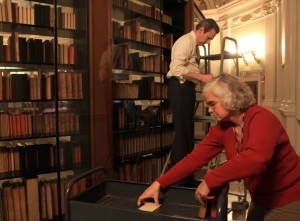
Anna Bryan and Eric Frazier reshelve books from the “Thomas Jefferson’s Library” exhibition. / Abby Brack Lewis
The books all were drawn from the “Thomas Jefferson’s Library” exhibition at the Library of Congress, and each ribbon indicates a book once owned by Jefferson himself.
The exhibition is one of the Library’s most popular attractions – a physical representation of the intellectual curiosity of a Founding Father and a tangible connection to the towering historical figure who personally picked out and read every title.
Jefferson’s books aren’t, however, just for show: More than ever, Dimunation says, those volumes serve as a working collection that helps scholars gain a better understanding of Jefferson and his world.
Once infrequently used, Jefferson’s books now are regularly requested by researchers – typically 15 to 18 volumes each week.
“Not only is Jefferson’s library the foundation of the Library of Congress, it’s the foundation of the accessible library,” Dimunation says. “These books aren’t being artfully arranged to look used. We’re actually pulling books out on almost a daily basis. The reason these books look like they’re coming and going is because they’re coming and going.”
Over the first four days of this “slow” week, researchers requested the nine titles resting on that vault shelf – among them, Jefferson’s copy of the Constitution; John Adams’ “A Defence of the Constitution”; a work about Italian musical theater; two histories of the American Revolution; and “Virginia,” a book published in 1650 by Edward Williams extolling the virtues – the potential for silkworm farming, for instance – of what would be Jefferson’s home state.
The increase in research requests in recent years is due in part, Dimunation says, to the exhibition, which re-creates the library purchased by Congress from Jefferson after the British burned the U.S. Capitol in 1814 and, with it, the congressional library.
Jefferson sold 6,487 of his own books to Congress as a replacement – volumes that became the foundation of the Library of Congress collections.
Another fire, in 1851, destroyed two-thirds of those books. In 1998, the Library of Congress decided to reconstruct Jefferson’s library by seeking out identical editions of titles lost in that blaze.
The exhibition opened in 2000, displaying the original Jefferson books that survived the fire – marked with the green ribbons – alongside those identical editions acquired from elsewhere in the Library collections or by purchase or donation.
The exhibition and its online counterpart, Dimunation says, have raised awareness among researchers of available titles. “People are beginning to find them online,” he says.
There is no typical research topic – the subject matter is as wide-ranging as Jefferson’s intellectual interests, from Restoration Theater to Persian history to Palladian architecture to the spread of Italian philosophical ideas during the 18th century.
No subject was too obscure to draw Jefferson’s interest – a boon to scholars two centuries later. One researcher recently requested a book on phlogistons, a hypothetical substance once thought to be the combustible part of all flammable materials.
Jefferson had it covered.
“The topics can run pretty wild,” Dimunation says.
About one-third of requests are related to research about the man himself – Jefferson and slavery, for example, or Jefferson and music (he played the violin and made annotations on music).
But most researchers are studying topics related to the period, not the person, and they often don’t know they are requesting books that once belonged to Jefferson – a sometimes-intimidating surprise.
One researcher requested a book on Restoration Theater and was shown how to handle the volume and asked to keep the green ribbon visible in its pages.
“Why?” she asked.
Told the ribbon indicates the book belonged to Jefferson, she threw her hands back and said, “I don’t want to work with it.”
“You’re going to have to,” Dimunation told her. “It’s the only copy in the library.”
The most-requested volumes, Dimunation says, are Jefferson’s original copies of “The Federalist,” the Koran and “Notes on the State of Virginia,” a book he authored.
Scholars often want to study this Koran – a 1764 edition of a translation produced by George Sale three decades earlier – to better appreciate Jefferson’s own understanding of Islam. Sale’s Koran was the first to be translated directly from the Arabic into English and is credited with introducing the sacred text to the West.
“The researchers want to see what the English version of the Koran is imparting to Jefferson in terms of his understanding of Arabic law,” Dimunation says.
For many, it’s also a moving experience.
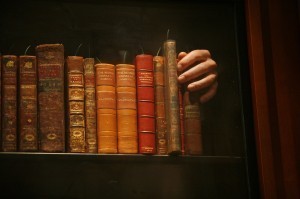
Photo by Abby Brack Lewis
“I think for people of Muslim faith, it’s profound,” Dimunation says. “It seems to be a profound moment.”
In his day, Jefferson owned the largest personal library in the United States. He had titles that couldn’t be found anywhere else in the country, Dimunation says, and people traveled long distances just to see the library and use the books.
Two centuries later, they still do.
“The collection is meant to be the sum of human endeavor, the universal effort of humankind,” Dimunation says. “That all these disparate people find spokes to grab onto and find access into the collection is, I think, pretty terrific.
“Jefferson would be thrilled.”
February 25, 2013
Leading a Library with a Long, Long Legacy
You’ve heard, no doubt, about the Great Library of Alexandria, Egypt, which was destroyed in a fire back in antiquity. (There are still debates about who torched it and why. We’ll probably never know.)
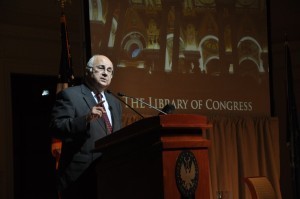
Ismail Serageldin of the Bibliotheca Alexandrina speaks at the First International Summit of the Book in December
You may also have heard that the national library of Egypt – the Bibliotheca Alexandrina – was rebuilt in an architecturally and intellectually marvelous way a little more than a decade ago, and is under the direction of Ismail Serageldin, a renowned thinker, writer and speaker.
Dr. Serageldin, at the invitation of Librarian of Congress James H. Billington, will give two public lectures at the Library of Congress on Friday, March 8. The first talk – at noon in Room 119 of the Library’s Thomas Jefferson Building at 10 First St., S.E. in Washington, D.C. – will be on “The Loss and Rebirth of the Library of Alexandria.” The second lecture, in the Library’s Coolidge Auditorium on the ground floor of the Thomas Jefferson Building, will take place at 7 p.m. following a reception at 6:30 p.m. in the Library’s Great Hall. Serageldin will speak on the topic “The Knowledge Revolution and the Future of Libraries.” These lectures will be free and open to the public; no tickets are necessary.
“I am delighted that my friend and fellow explorer of the life of the mind will return to the Library of Congress to share his insights,” said Billington, who invited Serageldin to deliver the March lectures following the First International Summit of the Book in December, an event held at the Library of Congress that Serageldin keynoted. (You can see that speech here.)
Serageldin, in addition to directing his nation’s library, also chairs the boards of directors for each of the Bibliotheca Alexandrina’s affiliated research institutes and museums. He serves as chair and member of a number of advisory committees for academic, research, scientific and international institutions and civil-society efforts which includes the Institut d’Egypte (Egyptian Academy of Science), U.S. National Academy of Sciences (Public Welfare Medalist), the American Philosophical Society, TWAS (Academy of Sciences for the Developing World), the Indian National Academy of Agricultural Sciences and the European Academy of Sciences and Arts.
He is former chairman of the Consultative Group on International Agricultural Research (CGIAR, 1994-2000), founder and former chairman of the Global Water Partnership (GWP, 1996-2000) and the Consultative Group to Assist the Poorest (CGAP), a microfinance program (1995-2000) and was professor of the International Savoirs Contre Pauvreté (Knowledge Against Poverty), at Collège de France, Paris, and distinguished professor at Wageningen University in the Netherlands.
He has also served in a number of capacities at the World Bank, including as vice president for environmentally and socially sustainable development (1992-1998), and for special programs (1998-2000). He has published more than 60 books and monographs and over 200 papers on a variety of topics including biotechnology, rural development, sustainability, and the value of science to society.
He holds a Bachelor of Science degree in engineering from Cairo University and master’s degree and a Ph.D. from Harvard University; he has received 33 honorary doctorates
Come to these excellent – and free – events!
February 22, 2013
A Whale of an Acquisition
“Moby Dick,” Herman Melville’s tale of high-seas adventure, heroic determination and the power of man, has been heralded as one of the greatest novels in the English language. Now, perhaps it can be given the same commendation in picture writing.

 ♥ You’ve probably seen these symbols in text messages and emails. So imagine an entire book translated into these little emoticons. Data engineer Fred Benenson did just that with the classic in his re-imagined translation, “Emoji Dick.” And the Library of Congress recently added the work to its collections.
♥ You’ve probably seen these symbols in text messages and emails. So imagine an entire book translated into these little emoticons. Data engineer Fred Benenson did just that with the classic in his re-imagined translation, “Emoji Dick.” And the Library of Congress recently added the work to its collections.
In 2009, Benenson started a Kickstarter campaign to fund the project and within a month raised enough money to put it together. He contracted thousands of people to translate one sentence of the book into emoji, had the best ones voted into place and compiled the book from those.
In his Kickstarter proposal, Fred explained, “I’m interested in the phenomenon of how our language, communications and culture are influenced by digital technology. Emoji are either a low point or a high point in that story, so I felt I could confront a lot of our shared anxieties about the future of human expression by forcing a great work of literature through such a strange new filter.”
Buying into Fred’s premise was Michael Neubert, a recommending officer for the Library’s collections. He caught wind of the project through online news sources and was able to reel the book in for the Library.
“I am very pleased that the Library was able to add this work to its collections,” Neubert said. “There is, in the literal sense, no other book in the Library’s collections like it.
“What is striking for the Library’s collections about this work is that it takes a known classic of literature and converts it to a construct of our modern way of communicating, making possible an investigation of the question, ‘is it still a literary classic when written in a kind of smart phone based pidgin language?’” he added. “Simply demonstrating that it is possible is interesting in that regard.”
The book also represents a successful example of crowdsourcing – not only in the funding of the project through Kickstarter but also in using a crowd to produce the book with Amazon Mechanical Turk.
According to Neubert, the bibliographic record is the only one in the roughly 14 million items cataloged in the Library’s system that credits the crowdsource Amazon Mechanical Turk for any creative role.
“Emoji Dick” joins many other versions of Melville’s “Moby Dick” in its collections, including a 2008 graphic novel version, a 2007 pop-up book and a 1984 adaptation for young readers. The classic novel also appears as part of Melville compilation volumes, with different editors and introductions, translated versions in Chinese, Russian and German, and of course the original version from 1851 recently featured in the Library’s “Books That Shaped America” exhibition.
Librarian of Congress James H. Billington goes on to talk about “Moby Dick” and its importance in American literature.[media player not shown]
February 20, 2013
Library In The News: January Edition
The Library of Congress exhibition “The Civil War in America” and Poet Laureate Natasha Trethewey continued to make the news last month.
Edward Rothstein toured the exhibition for The New York Times. “This is one reason the Library of Congress exhibition ‘The Civil War in America,’ which opened late last year in honor of the war’s sesquicentennial, is so fascinating. It doesn’t explicitly ask questions about means and ends, but we can’t help thinking about them as the letters, diaries, documents and images accumulate.”
In addition, the Washington Post’s Michael O’Sullivan reviewed the show, calling it a “sober chronology of letters, photographs, books, artwork, maps and other ephemera” and “surprisingly moving.”
In January, the Library put on temporary display the first draft of the Emancipation Proclamation in the Civil War exhibit. Picking up that announcement were several local broadcast and newspaper outlets.
Also put on temporary display was a Bible, belonging to Abraham Lincoln, that President Barack Obama used for his second inauguration. You can read more about it this previous blog post. Outlets including USA Today, CNN and The Baltimore Sun featured stories.
Also in commemoration of the Civil War and coinciding with the exhibition, Poet Laureate Natasha Trethewey did a poetry reading and lecture at the Library on January 30. A few outlets caught up with her prior to the event and as she began her in-office residence at the Library’s Poetry and Literature Center – the first laureate to do so.
“Being in the presence of history and a place so rooted in the national imagination – it’s so interesting to me,” she told The Washingtonian. “I like it very much. I think I could live here.”
Covering her lecture was Washington Post reporter Ron Charles. Trethewey discussed Walt Whitman and his war poems. “Her lecture elegantly blended scholarship, cultural criticism and poetry.”
In a last bit of news, Glenn Fleishman of Boing Boing took a tour of the Library’s Packard Campus for Audio-Visual Conservation to “find the heart of the nation’s audiovisual memory.” He went on to discuss the Library’s efforts in preserving resources using old nitrate film base, copyright restrictions on films and sound recordings and the creation of digital versions of master recordings.
February 19, 2013
National Book Festival: Save the Date, Take the Survey
There’s news on two fronts for you book-lovers out there: first, the 13th annual Library of Congress National Book Festival will be held on the National Mall between 9th and 14th Streets on Saturday, Sept. 21, 2013, from 10 a.m. to 5:30 p.m. and on Sunday, Sept. 22, 2013 from noon to 5:30 p.m., rain or shine. The event is free and open to the public.
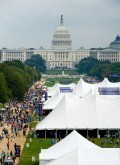
Crowds enjoy fine weather at the Library of Congress National Book Festival
Part two: Festival fans and other lovers of the printed word are invited to take a “Books That Shaped the World” survey on the Library of Congress National Book Festival website. The Library, which invited public comment on “Books That Shaped America” in 2012 (spurring a lively dialogue) will continue its multi-year Celebration of the Book with a look at “Books That Shaped the World” in 2013.
“Last year’s Festival drew more authors and more readers than ever before” said Librarian of Congress James H. Billington. “The excitement is building once again as we invite a public conversation about the power of books to change the world.”
We’ll reprise the features fans have come to know and love about the Festival – scores of authors presenting in pavilions and signing their books, plus rewarding literacy- and Library of Congress-related activities for people of all ages. In addition, there are plans to broaden the reach of the popular “A Book That Shaped Me” essay contest for rising 5th- and 6th-graders. Schoolchildren in the Mid-Atlantic region – the District of Columbia, Maryland, Virginia, Delaware and Pennsylvania – will be invited to submit essays. Keep an eye on the Library of Congress National Book Festival website for updates and the launch of this year’s essay contest …
Check out the survey at the Library of Congress National Book Festival website and tell us which books you think shaped the world, and why!
The Feminine Mystique at 50
(The following is a guest post by Audrey Fischer, editor of the Library of Congress Magazine.)
It’s been 50 years since pioneering women’s rights activist Betty Friedan stunned the nation with her controversial book, “The Feminine Mystique.”
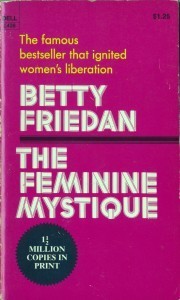 In what became known as a manifesto, Friedan urged women to eschew the cult of domesticity and address “the problem that has no name”—the feeling among many 1950s housewives that something was lacking in their lives. Offering an antidote—the pursuit of higher education and meaningful work—she raised the consciousness of her generation and those that followed over the past half-century. (Note: The 50th Anniversary Edition of “The Feminine Mystique” has just been published by W.W. Norton).
In what became known as a manifesto, Friedan urged women to eschew the cult of domesticity and address “the problem that has no name”—the feeling among many 1950s housewives that something was lacking in their lives. Offering an antidote—the pursuit of higher education and meaningful work—she raised the consciousness of her generation and those that followed over the past half-century. (Note: The 50th Anniversary Edition of “The Feminine Mystique” has just been published by W.W. Norton).
My mother was one of those women. Friedan’s words sent her back to college in 1964 to finish what she started before she dropped out to marry and start a family. At 42, she became a New York City teacher, a career that fed her soul—and her family—and afforded her a comfortable retirement 25 years later.
Multiply my mother’s experience a million-fold over the past five decades (during which time 3 million copies of Friedan’s book were sold) and you have a seismic change in society—women entered the workforce in record numbers, men began to help with housework and child care, and, just a few weeks ago, the ban was lifted on women in combat.
Friedan’s book can’t be credited with all of these changes, but it certainly deserves to be one of “The Books That Shaped America” as it was recently designated by the Library of Congress, along with 99 other titles.
In what was one of her last public appearances, Friedan spoke at the Library on March 10, 2005, to mark Women’s History Month. She died on Feb. 4, 2006, her 85th birthday.
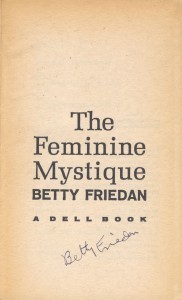 In her talk, the founder of the National Women’s Political Caucus and co-founder of NOW (National Organization for Women) lamented that “although women comprise 51 percent of the population they constitute only 12 percent of Congress.” With a record number of women in the Senate (20), the recently sworn-in 113th Congress has 101 women in its ranks (or about 19 percent) so progress continues to be made.
In her talk, the founder of the National Women’s Political Caucus and co-founder of NOW (National Organization for Women) lamented that “although women comprise 51 percent of the population they constitute only 12 percent of Congress.” With a record number of women in the Senate (20), the recently sworn-in 113th Congress has 101 women in its ranks (or about 19 percent) so progress continues to be made.
During her appearance at the Library, Friedan graciously signed my 1972 paperback copy of her book—purchased for $1.25 for a women’s studies class—thereby helping to shape me and another generation of women.
February 15, 2013
Last Word: Author Robert Caro on LBJ
(The following is an article from the January-February 2013 issue of the Library’s magazine, LCM, featuring an excerpt from an interview with historian and author Robert Caro about Lyndon Baines Johnson.)
LCM: You’ve spent more than 30 years researching and writing about Lyndon Johnson, with a final volume yet to be published. What aspects of Johnson’s character or career most fascinate you and how do they relate to today’s congressional climate?
Caro: The thing that fascinates me most about Johnson is his absolute genius in the use of political power. … Conditions are different today. But Johnson always found a way to get power for himself out of the conditions in some institution, and make the institution work. I think he had such a genius in acquiring and using power that he would become a legislative force no matter what the conditions were.
LCM: In this election season, one thinks about the extraordinary conditions under which President Johnson was inaugurated following Kennedy’s assassination. How do you think he felt about his second inaugural considering the tragic circumstances of his first one?
Caro: Johnson’s key words in his first speech, to the joint session of Congress, four days after Kennedy is assassinated, are, “Let us continue.” First, he pushes through Kennedy’s stalled legislation, the civil rights bill, the tax cut bill. Then he tells friends, “Now it’s time to make the presidency my own.” In his inaugural speech in January 1964, he sets out a new course, a new policy—the War on Poverty—which is his great initiative. And he follows that up with the Great Society so we see a transition from continuity to making the presidency his own.
LCM: You’ve recently said that Barack Obama is Lyndon Johnson’s legacy. Can you elaborate on that?
Caro: Johnson passes the Voting Rights Act in 1965, which really brings black Americans fully into the American political process. Forty-three years later, in 2008—which really is just a blink of history’s eye—there is an African-American in the White House. That’s what I mean by saying that Barack Obama is Lyndon Johnson’s legacy.
LCM: The nation will be marking the 150th Anniversary of the Civil War. Like Lincoln, Johnson’s true motives on promoting racial equality have been questioned. Have you come to any conclusions about that?
Caro: The reason it’s questioned is that for no less than 20 years in Congress, from 1937 to 1957, Johnson’s record was on the side of the South. He not only voted with the South on civil rights, but he was a southern strategist, but in 1957, he changes and pushes through the first civil rights bill since Reconstruction. He always had this true, deep compassion to help poor people and particularly poor people of color, but even stronger than the compassion was his ambition. But when the two aligned, when compassion and ambition finally are pointing in the same direction, then Lyndon Johnson becomes a force for racial justice, unequalled certainly since Lincoln.
MORE INFORMATION
Listen to a podcast of the full interview.
Download the January-February 2013 issue of the LCM in its entirety here. You can also view the archives of the Library’s former publication from 1993 to 2011.
February 14, 2013
A Very Special Kaye
The following is a guest post from Mark Hartsell, editor of the Library’s staff newsletter, The Gazette.
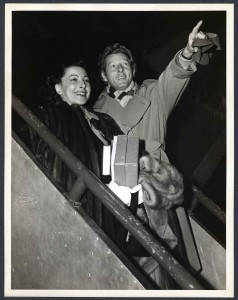
Danny Kaye and Sylvia Fine arrive in London for a royal command performance in 1948. Kaye/Fine Collection, Music Division
Danny Kaye was many things and, at the same time, a one and only: a live performer who combined comedy, song and dance in an utterly unique way; a celebrity humanitarian, one of the first; an actor with big box-office hits; a conductor of classical music who couldn’t read a note.
A Library of Congress exhibition that opens today explores the legacy of Kaye and his wife, songwriter Sylvia Fine, who managed his career and helped make him one of the biggest stars in the world during the 1940s, ’50s and ’60s.
Kaye appeared in hit films such as “White Christmas” and “Hans Christian Andersen” and sold out live performances around the planet. Tongue-twisting tunes and dialogue were a hallmark of his work in movies and onstage – in “Tchaikowsky,” a high-speed staple of his live act, he sang the names of 50 Russian composers in 38 seconds.
The quick tongue, the quirky bits and the personal connection he developed with audiences made him so popular that fans would queue up for days for tickets to his shows. “I’m supposed to be a master of oratory and yet cannot cast a spell over audiences like you do,” Winston Churchill told Kaye after a performance at the London Palladium in 1949.
Kaye devoted much of his life to humanitarian causes. In 1954, he was named the first good will ambassador for UNICEF, a position he held until his death in 1987. Kaye, who couldn’t read music, also developed a side career conducting symphony orchestras to raise funds for charitable causes – in his own comic fashion, of course. Kaye would direct the orchestra with his feet or conduct “Flight of the Bumblebee” with a flyswatter. The orchestras and audiences loved it.
You might love his work, too: Watch a clip of one of Kaye’s best-known bits – the tongue-twisting “flagon with the dragon” scene from “The Court Jester.” Check out the Library’s online exhibition, “ Danny Kaye and Sylvia Fine: Two Kids from Brooklyn.”
February 13, 2013
Save the Sounds
The following is a guest post by the Library’s Director of Communications, Gayle Osterberg.
During one of my first visits to the Library of Congress’s Packard Campus for Audio-Visual Conservation, one of the division chiefs there pointed out the 35 mm projector in the theater. He commented that the sound of 35 mm film being fed through a projector is an “endangered sound.” My furrowed brow and quizzical look prompted him to expand on that thought by explaining that the Library has in its collections recordings of many sounds that are scarce if not entirely extinct – steam engine whistles, dial telephones and manual typewriters.
It had never occurred to me to think of sound that way.
Fast forward to today’s sound preservation challenges – including variations in quality of compressed mp3 files to born-digital materials that are not consistently procured by national libraries or archival institutions, and it could be that the sounds of today are even more endangered than those of yesterday.
Such questions have been the business of a team of experts assembled by the Library of Congress to write the National Recording Preservation Plan (PDF, 1.7MB), a historic blueprint for saving America’s recorded sound heritage for future generations. The congressionally mandated plan, introduced today by the Library and the National Recording Preservation Board, spells out 32 short- and long-term recommendations involving both the public and private sectors. These recommendations cover infrastructure, preservation, access, education and policy strategies.
As Librarian of Congress James Billington explains, “our collective energy in creating and consuming sound recordings has not been matched by an equal level of interest in preserving them for posterity. Radio broadcasts, music, interviews, historic speeches, field recordings, comedy records, author readings and other recordings have already been forever lost to the American people.”
No one alive today remembers a time before recorded sound, but as a medium it is only about 150 years old (timeline, PDF 180KB) — still a young format when one considers that the first book published in the west on a printing press is nearly six centuries old. And while the basics of a printed book haven’t changed much in all that time, the devices used to record and listen to sound have evolved almost continuously since the earliest recording. So the mission of collecting and preserving sounds starts out at a tremendous disadvantage when compared to a medium like the book.
The Library will continue working collaboratively with the organizations and individuals involved in putting together this groundbreaking plan to pursue its implementation. But this plan is also a call to action for anyone who agrees sound recordings are important to our cultural heritage – broadcasters, performers, audio engineers, preservationists, archivists, librarians – all have a role to play. And, in fact, many are offering support today (PDF, 164KB).
Broadcaster and member of the National Radio Hall of Fame Bob Edwards says, “Sound recordings offer a rich documentation of the broad scope of America culture. Our national story is incomplete if the audio record of our rich and diverse history is not preserved in the best condition technology allows.”
Tim Brooks, president of the Association for Recorded Sound Collections, says, “We believe this bold new effort represents a major breakthrough in efforts to secure for posterity historical audio recordings, and we will do everything we can to help it succeed.”
Composer Stephen Sondheim says, “As a composer who has been both informed and influenced by sound recordings, I feel passionately that they are a heritage too easily lost, and one which requires all due diligence to preserve. The Library of Congress National Preservation Recording Plan represents our best and most thoughtful chance to preserve the country’s musical creativity.”
Neil Portnow, president/CEO of the Recording Academy and the GRAMMY Foundation, says, “The Recording Academy and the GRAMMY Foundation support the objectives of the National Plan and are committed to working in partnership with the Library of Congress and others to implement its important recommendations.”
As the Washington Post’s always-clever Chris Richards wrote today, sounds like a plan.
Library of Congress's Blog
- Library of Congress's profile
- 74 followers



